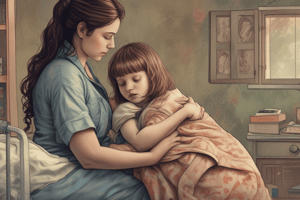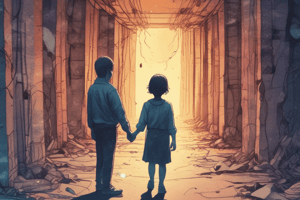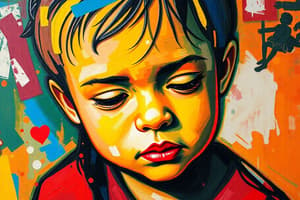Podcast
Questions and Answers
Sixty percent of contact sexual abuse reported by children in the UK was perpetrated by other children and young people under the age of 18 years.
Sixty percent of contact sexual abuse reported by children in the UK was perpetrated by other children and young people under the age of 18 years.
True (A)
Children are more likely to report abuse when the offender is a family member.
Children are more likely to report abuse when the offender is a family member.
False (B)
Sexual abuse of children occurs mostly in low socioeconomic groups.
Sexual abuse of children occurs mostly in low socioeconomic groups.
False (B)
Physical violence and penetrative intercourse during abuse tend to result in more severe effects.
Physical violence and penetrative intercourse during abuse tend to result in more severe effects.
About 13% of all adult psychopathology in an Australian study was found to be due to the effects of childhood sexual abuse.
About 13% of all adult psychopathology in an Australian study was found to be due to the effects of childhood sexual abuse.
A full skeletal survey radiography may reveal bone abnormalities like osteogenesis imperfecta.
A full skeletal survey radiography may reveal bone abnormalities like osteogenesis imperfecta.
The first priority when non-accidental injury is suspected is to report it to the police.
The first priority when non-accidental injury is suspected is to report it to the police.
Careful assessment must be done prior to reunification due to the high risk of serious injury or death.
Careful assessment must be done prior to reunification due to the high risk of serious injury or death.
The chances of another severe injury to an abused child are between 20% and 40%.
The chances of another severe injury to an abused child are between 20% and 40%.
Emotional abuse rarely accompanies other forms of child abuse.
Emotional abuse rarely accompanies other forms of child abuse.
If parents refuse help and emotional abuse is creating serious problems, there may be a need to involve social services.
If parents refuse help and emotional abuse is creating serious problems, there may be a need to involve social services.
Child neglect can only be detected by teachers.
Child neglect can only be detected by teachers.
Neglect of education is one form of child neglect.
Neglect of education is one form of child neglect.
Early intervention has no impact on the outcomes for abused children.
Early intervention has no impact on the outcomes for abused children.
Doctors sometimes see children who have a failure to thrive without biological causes.
Doctors sometimes see children who have a failure to thrive without biological causes.
Non-organic failure to thrive (NOFTT) is most frequent under 5 years of age.
Non-organic failure to thrive (NOFTT) is most frequent under 5 years of age.
Deprivation of food and close affection can cause NOFTT in children.
Deprivation of food and close affection can cause NOFTT in children.
Females have higher rates of non-contact abuse compared to males.
Females have higher rates of non-contact abuse compared to males.
Cognitive and developmental delay with impairment of language skills is one of the symptoms described for PSSS.
Cognitive and developmental delay with impairment of language skills is one of the symptoms described for PSSS.
One in two women is confronted with combined sexual abuse during childhood.
One in two women is confronted with combined sexual abuse during childhood.
Child maltreatment only includes physical abuse and neglect.
Child maltreatment only includes physical abuse and neglect.
Literature on child abuse primarily refers to low-income countries.
Literature on child abuse primarily refers to low-income countries.
Fetal abuse can include physical assault and substance use during pregnancy.
Fetal abuse can include physical assault and substance use during pregnancy.
Neglect includes behaviors such as abandonment and failure to thrive.
Neglect includes behaviors such as abandonment and failure to thrive.
One in fifty children experiences some form of maltreatment.
One in fifty children experiences some form of maltreatment.
Safeguarding is a term used to denote ensuring that children come to the least harm and are protected.
Safeguarding is a term used to denote ensuring that children come to the least harm and are protected.
Child maltreatment does not occur in middle-income countries.
Child maltreatment does not occur in middle-income countries.
Children who have experienced one form of maltreatment are 2-3 times more likely to experience other forms.
Children who have experienced one form of maltreatment are 2-3 times more likely to experience other forms.
Factors contributing to child maltreatment can include family violence and young age of parents.
Factors contributing to child maltreatment can include family violence and young age of parents.
No single risk factor is necessary or sufficient for maltreatment to occur.
No single risk factor is necessary or sufficient for maltreatment to occur.
The prevalence of physical abuse in childhood is typically reported to be between 5-15%.
The prevalence of physical abuse in childhood is typically reported to be between 5-15%.
Multiple bruising, burns, and bone fractures are among the most common forms of injury in physically abused children.
Multiple bruising, burns, and bone fractures are among the most common forms of injury in physically abused children.
Relatives, neighbours, and school staff are unlikely to recognize and report physical abuse in children.
Relatives, neighbours, and school staff are unlikely to recognize and report physical abuse in children.
Children who are smothered often show physical abuse symptoms but are typically reported to have experienced an apnoeic attack by their parents.
Children who are smothered often show physical abuse symptoms but are typically reported to have experienced an apnoeic attack by their parents.
A delay in seeking help and inconsistent parental accounts of injuries should arouse suspicion of physical abuse.
A delay in seeking help and inconsistent parental accounts of injuries should arouse suspicion of physical abuse.
Children who have been physically abused often have high self-esteem and actively seek social interactions.
Children who have been physically abused often have high self-esteem and actively seek social interactions.
Doctors who suspect physical abuse must refer the child to hospital but should avoid informing a paediatrician or casualty officer.
Doctors who suspect physical abuse must refer the child to hospital but should avoid informing a paediatrician or casualty officer.
Formal photographs of injuries should be taken during the admission of a child suspected to have been abused.
Formal photographs of injuries should be taken during the admission of a child suspected to have been abused.
A parent with a criminal record is not considered a risk factor for child maltreatment.
A parent with a criminal record is not considered a risk factor for child maltreatment.
Inpatient admission is only required for cases of severe physical abuse.
Inpatient admission is only required for cases of severe physical abuse.
It is necessary for all children who have experienced sexual abuse to undergo therapy.
It is necessary for all children who have experienced sexual abuse to undergo therapy.
A multidisciplinary approach, often including police and judicial involvement, is usually needed to establish whether abuse has taken place.
A multidisciplinary approach, often including police and judicial involvement, is usually needed to establish whether abuse has taken place.
Treating child and adolescent abusers requires coordinated support solely from child protection services.
Treating child and adolescent abusers requires coordinated support solely from child protection services.
Families of sexually abused children often deny the seriousness of the abuse and other family problems.
Families of sexually abused children often deny the seriousness of the abuse and other family problems.
Cognitive behavior therapy for child and adolescent abusers has only been used on an individual basis.
Cognitive behavior therapy for child and adolescent abusers has only been used on an individual basis.
Meta-analyses have shown that combining cognitive behavior therapy with supportive, psychodynamic, or play therapy yields large to moderate effect sizes.
Meta-analyses have shown that combining cognitive behavior therapy with supportive, psychodynamic, or play therapy yields large to moderate effect sizes.
Flashcards are hidden until you start studying
Study Notes
Physical Abuse (Non-Accidental Injury)
- Estimates of physical abuse in children vary between 5-15% depending on the definition used.
- Common forms of injury include multiple bruising, burns, abrasions, bites, torn upper lip, bone fractures, and subdural or retinal haemorrhages.
- Suspicion of physical abuse should be aroused by the pattern of injuries, previous history of suspicious injury, vague or inconsistent account of injuries, delay in seeking help, and incongruous parental reactions.
- Abused children may exhibit fearful responses to parents, anxiety, unhappiness, social withdrawal, low self-esteem, and aggression.
Clinical Features
- Parents may bring an abused child to the doctor with an injury said to have been caused accidentally.
- Relatives, neighbours, school staff, or other people may report the problem to police, social workers, or voluntary agencies.
- Infants may be smothered (often with a pillow) and parents might report an apnoeic attack.
Assessment and Management
- Doctors should always be alert to the possibility of physical abuse.
- They need to be aware of the risks to children with certain characteristics or who are being cared for by parents with predisposing factors.
- Professionals need regular child protection training to be aware of different ways abused children might present.
- The majority of these children are thought to be missed by health services.
- Doctors who suspect abuse should refer the child to hospital and inform a paediatrician or casualty officer of their suspicions.
- Inpatient admission should be arranged for all children in whom non-accidental injury is suspected.
Risk Factors for Child Maltreatment
- Young age of parents
- Low education or intelligence
- Social isolation
- Breakdown of relationship with partner
- Poor parenting skills
- Experience of maltreatment as a child
- Criminal record
- Impaired emotional regulation
- Psychiatric problems
Child Maltreatment
- Definition: all forms of physical and/or emotional ill treatment, sexual abuse, neglect, or commercial or other exploitation.
- Prevalence: estimated to be widespread throughout the world, but literature primarily refers to high-income countries.
- Factors contributing to child maltreatment can be grouped into three categories: environment, parents, and children.
Types of Maltreatment
- Emotional abuse: age-inappropriate behavior, aggression, body-rocking, eating and feeding difficulties, encopresis, wetting, dissociation, cutting, and other forms of self-harm.
- Physical abuse: abrasions, teeth marks, bruises, burns and scalds, cuts, eye injuries, fractures, intra-abdominal injuries, oral injuries, petechiae, retinal haemorrhage, subdural haemorrhage.
- Sexual abuse: anal symptoms and signs, anogenital injuries, dysuria, genital symptoms and signs, sexualized behavior, pregnancy.
- Neglect: abandonment, failure to thrive, lack of supervision, poor hygiene, persistent infestations, poor medication adherence.
Common Issues
- Nearly one in five children experience some forms of maltreatment.
- Children who have experienced one form of maltreatment are 2-3 times more likely to experience other forms of maltreatment.
- Safeguarding is a term used to denote the consideration of and care needed for children who are either at risk of or who have a past or current history of child maltreatment.
- Fetal abuse refers to behaviors detrimental to the fetus, including physical assault and substance use during pregnancy.
- Fabricated and induced illness refers to apparent illness in children, which has been fabricated by the parents, or induced by parents, such as by giving medication or other substances when not indicated.
Aetiology
- Although several risk factors show a statistical association with child maltreatment, no single risk factor is either necessary or sufficient for maltreatment to occur.
- The most useful way to frame the many risks is to consider them in a multilevel model, with individual, family, and community factors considered alongside appreciating the bidirectional nature of the child-adult interaction and how this might influence maltreatment.
Radiological Examination
- Departments of the hospital and a full skeletal survey radiography may reveal past injuries or bone abnormalities like osteogenesis imperfecta.
- A CT scan may be necessary if a subdural haemorrhage is suspected.
Non-Accidental Injury
- The first priority is child safety when it has been determined that non-accidental injury is likely.
- The process will differ based on the administrative setup of the country in question.
- The Social Services Department in the UK is responsible for child protection - police departments also get involved.
Return to Family
- Parents are not always the best option for the child to return to.
- There may be a high risk of serious injury or even death to children who have been returned to their parents.
- Careful assessment must be done prior to reunification.
Prognosis
- Children who have been subjected to physical abuse are at an increased risk of further problems.
- The chances of another severe injury are between 10% and 30%, and occasionally they are fatal.
- The primary goal of intervention should be to prevent further mistreatment.
- Physical disorders, developmental delays, learning difficulties, and behavioural/emotional problems are significantly higher in those who are abused.
- Early intervention can be helpful, but many adults who were victims of abuse may struggle to parent children.
Emotional Abuse
- Emotional abuse is usually a pattern of neglect or rejection that impacts a child's development.
- It can include overprotection, verbal abuse, or scapegoating, which can also negatively impact development.
- Emotional abuse often accompanies other forms of child abuse.
- The effects of emotional abuse on a child can manifest in physical issues, psychological problems, and behavioural disorders.
Management of Emotional Abuse
- The focus should be on assisting the parents with their own emotional issues and their relationship with the child.
- It is very difficult to persuade parents to accept help.
- If they refuse and the emotional abuse is creating serious problems, there may be a need to involve social services and consider options, like the steps taken to help those experiencing physical abuse.
Child Neglect
- Child neglect is defined as the failure to provide adequate care.
- It can involve emotional deprivation, educational neglect, physical neglect, lack of physical safety, or denial of access to medical or surgical treatment.
- It can lead to both physical and psychological harm, including academic difficulties and behavioural issues.
- The rates of neglect are higher than physical abuse.
- It can be detected by various people, including family, neighbours, teachers, doctors, and social workers.
- Neglect is often associated with negative circumstances, and is a common reason for children to be placed in foster care or other types of care.
Management of Child Sexual Abuse
- Initial management and protective measures for child sexual abuse are similar to those for physical abuse, including a decision about separating the child from the family.
- Intervening with families in which sexual abuse has occurred can be challenging due to denial of abuse and other family problems.
- In some cases, other family members, including children, may exhibit detrimental sexual behaviors.
- Not all children require therapy, but they need an appropriate narrative about their abuse and access to a supportive person who believes them.
- Research shows that psychotherapy, group therapy, and cognitive behavior therapy combined with other therapies can have large to moderate effect sizes.
- Cognitive behavior therapy, both individually and in groups, has been used to treat child and adolescent abusers.
- Structured group work is also used in treatment.
- Coordinated multidisciplinary support with child protection services is essential for effective treatment.
Studying That Suits You
Use AI to generate personalized quizzes and flashcards to suit your learning preferences.




